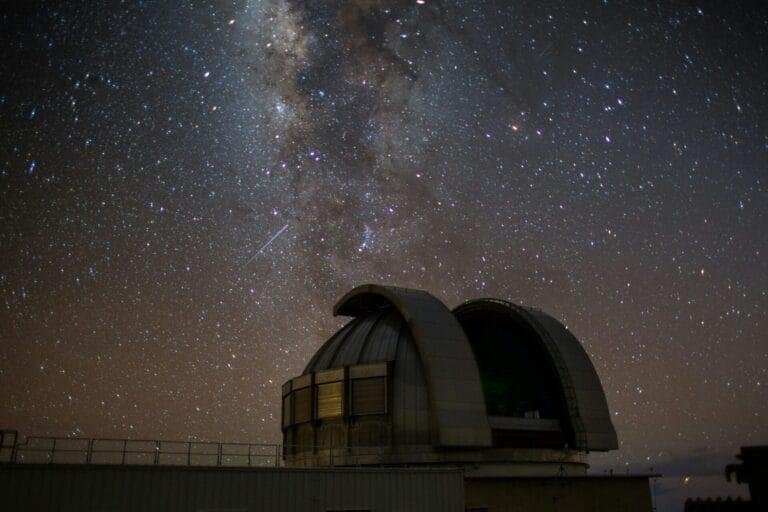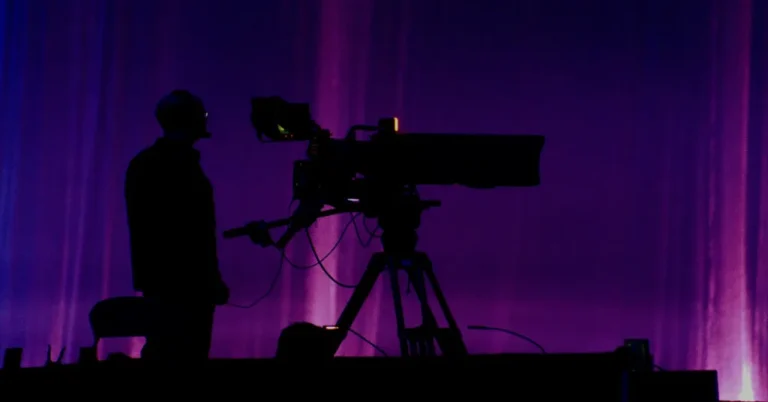Best Telescope to See Planets | Ultimate Buyer’s Guide
The first time you see Jupiter’s swirling clouds or Saturn’s sharp rings through a telescope is unforgettable. Planetary observing is one of the most rewarding experiences in the backyard. Offering breathtaking views of our solar system’s giants from your backyard. But with so many telescopes on the market, how do you know which one will give you the best views?
This guide will help you choose the right telescope for planetary observation. It will cover the key features, common pitfalls, and what to expect when you observe the planets.
Whether you’re a beginner or upgrading your setup, let’s find the perfect telescope to bring the solar system into focus. We’ll also discuss some common mistakes to avoid when selecting a telescope.
Why Observing Planets with the Best Telescope Is Fascinating
Planets are some of the brightest and most captivating objects in the night sky. Unlike stars, these planets are close enough for amateurs to see details, like clouds and moons. You can see them clearly, even with beginner telescopes.
Observing planets is not only a personal thrill but also a window into the workings of our solar system.
A good telescope helps you see amazing things. You can explore Jupiter’s Great Red Spot, Saturn’s rings, and even the phases of Venus. You can have an unmatched experience by seeing these details firsthand. To do so, equip yourself with the right tools.
The Role of Telescopes in Planetary Observation
Telescopes have changed how we view the night sky, allowing us to see fine details of bright planets that are invisible to the naked eye. However, not all telescopes are suitable for this type of observation. To truly enhance your stargazing experience, selecting a telescope specifically designed for planetary viewing is essential.
You need strong magnification, clear optics, and a stable mount to see planets well. This mix makes Jupiter’s bands and Saturn’s Cassini Division easy to see. They’re straightforward and stable.
Recommended Telescopes for Seeing Planets
Discover the top telescopes perfect for exploring planets in stunning detail. From beginner-friendly options to advanced models, find the ideal scope to bring Jupiter’s moons, Saturn’s rings, and Mars’ surface into focus. Your journey to the cosmos starts here
Best Beginner Telescope for Planets
Celestron StarSense Explorer LT 114 AZ
The Celestron StarSense Explorer LT 114AZ is perfect reflector telescope for novice planet explorers. It’s easy to set up and use, making it ideal for first-time stargazers.
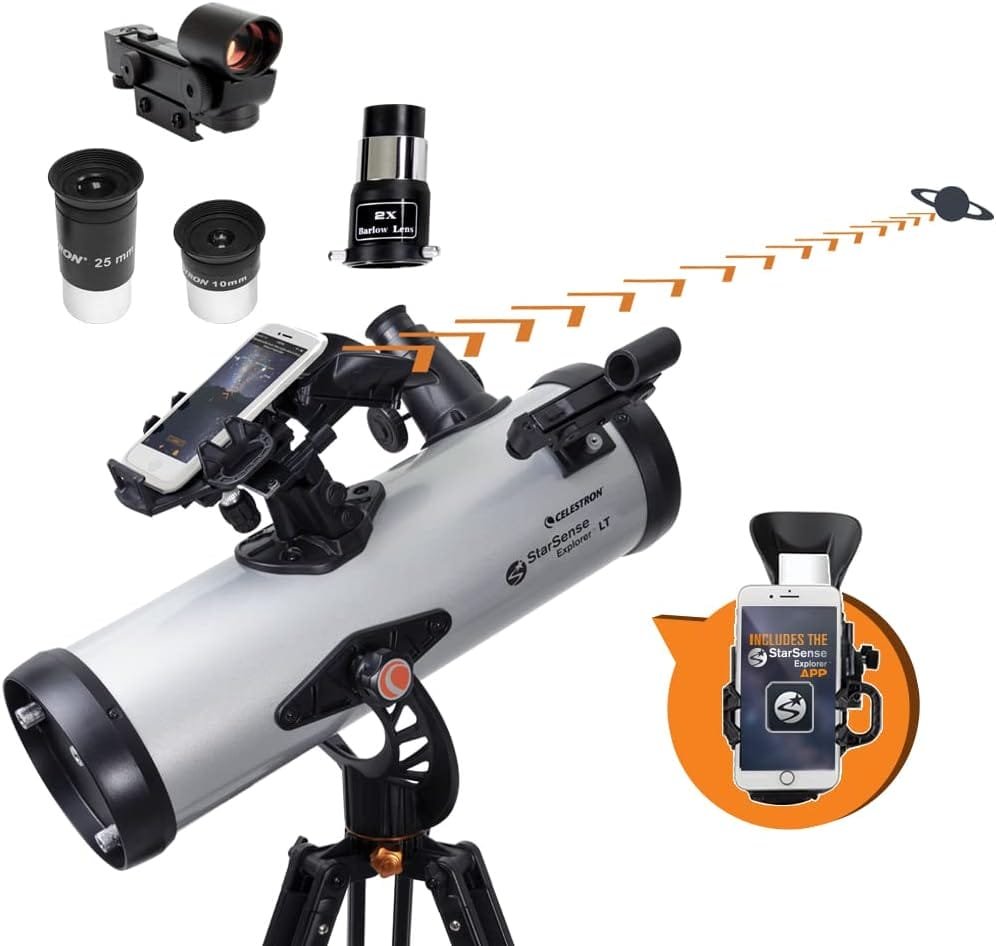
Celestron StarSense Explorer LT 114 AZ
The Celestron StarSense Explorer LT 114 AZ is a user-friendly reflector telescope designed for beginners and amateur astronomers.
This telescope’s unique feature is its StarSense technology. Just dock your smartphone and open the app, and it will guide you to planets, stars, and galaxies in the night sky—no experience needed!
This telescope has a 114mm aperture. It gathers enough light to reveal stunning views, including Jupiter’s clouds, Saturn’s rings, and the Moon’s craters. The AZ mount moves fluidly, allowing you to track objects with ease.
It’s lightweight and portable so you can take it to a dark-sky location for even better views. For a simple-to-use telescope that finds planets, try the StarSense Explorer LT 114AZ. It’s excellent for beginners.
Specs
| Specification: | Details |
|---|---|
| Type: | Newtonian Reflector |
| Aperture | 114 mm (4.5 inches) |
| Focal Length | 1000 mm (39.3 inches) |
| Focal Ratio | f/9 |
| Mount Type | Manual Alt-Azimuth |
| Weight | Total Kit Weight: 10.4 lbs (4.71 kg) |
| Maximum Magnification | 269x (though practical maximum may vary based on observing conditions) |
| Finderscope | StarPointer Red Dot Finderscope |
| Tripod Material | Steel, with 31.75 mm (1.25 inches) diameter legs |
| Optical Coatings | Glass mirrors coated with aluminum and SiO₂ |
| Accessories Included | 25 mm and 10 mm eyepieces, 2x Barlow lens, StarPointer finderscope, accessory tray, StarSense Explorer phone dock |
| Field of View | Approximately 1.2° with a 25 mm eyepiece |
| User Level | Beginner |
Pros
- Accurate object locating
- Intuitive app
- Portable design
Cons
- Vibration during use
- Single arm mount
Best Features
- Smartphone Integration
- Sky Recognition
- Easy Setup
- High-Quality Optics
Best Mid-Range Option
Sky-Watcher Heritage 150 Tabletop Dobsonian
The Sky-Watcher Heritage 150 is a compact but powerful Dobsonian telescope with a 150mm aperture. It collects enough light to show fine details on the Moon, planets, and some deep-sky objects, like star clusters and nebulae.
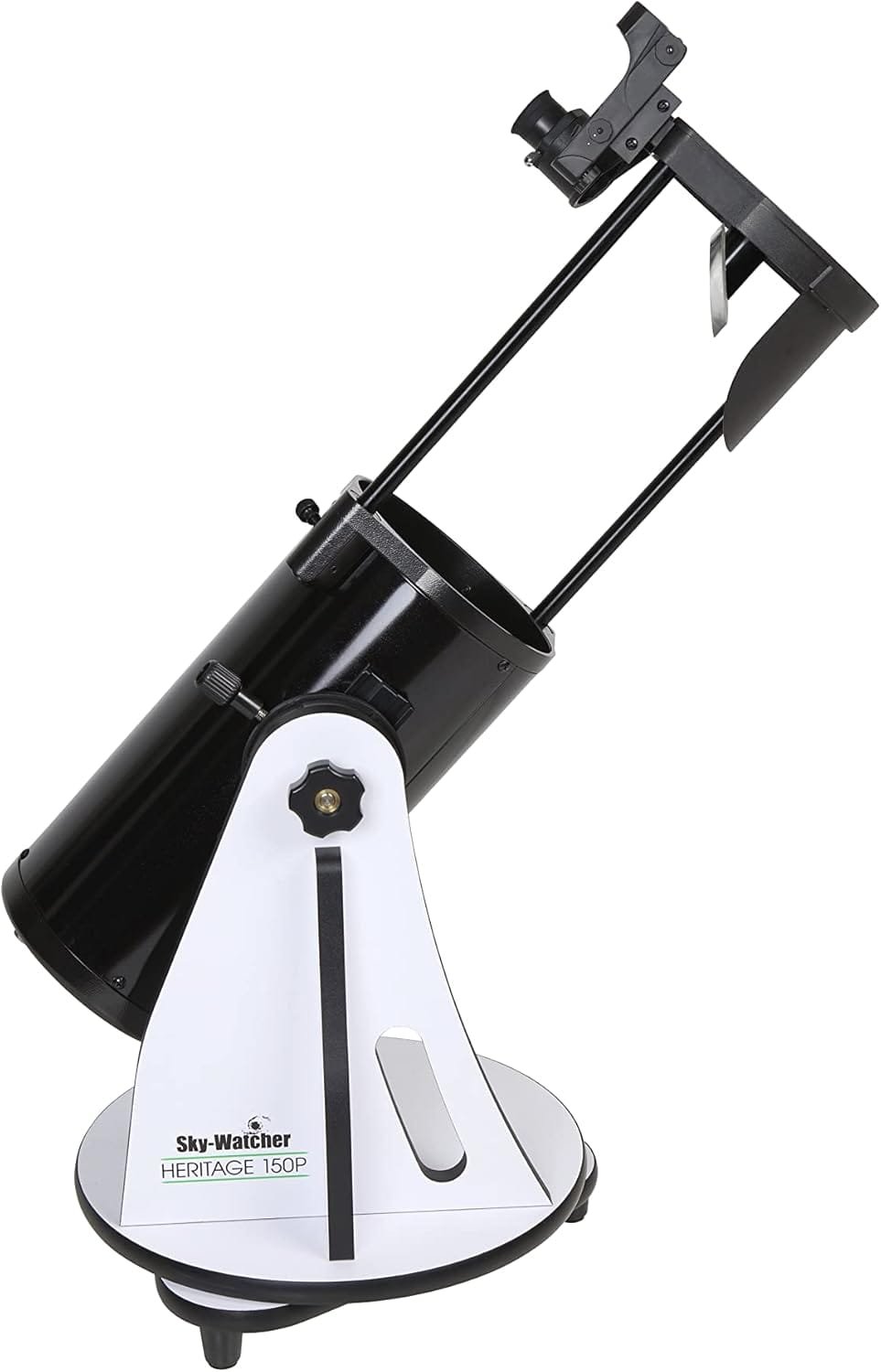
Sky-Watcher Heritage 150 Tabletop Dobsonian
The Sky-Watcher Heritage 150 Tabletop Dobsonian is a compact and portable reflector telescope with a 150mm aperture, offering excellent light-gathering capabilities for detailed views of the night sky.
This tabletop Dobsonian mount is stable and easy to use. Point and observe—no complicated setup is required. The wide field of view makes finding and tracking objects in the sky simple.
Its collapsible design makes it portable and easy to store. It’s an excellent choice for those who want to balance power and convenience.
The Sky-Watcher Heritage 150 is an excellent mid-range telescope with sharp, bright images. A Dobsonian telescope with an 8-inch aperture, ideal for sharp, detailed views of Saturn and Jupiter.
Specs
| Specification | Details |
|---|---|
| Type | Newtonian Reflector |
| Aperture | 150 mm (5.9 inches) |
| Focal Length | 750 mm |
| Focal Ratio | f/5 |
| Mount Type | Tabletop Dobsonian |
| Optical Coatings | Radiant™ Aluminum Quartz (RAQ™) |
| Optical Tube Design | Collapsible with struts; retracts to 16.75 inches for portability and extends to 48 inches during use |
| Focuser | 1.25-inch helical |
| Finderscope | Red dot finder |
| Eyepieces Included | 25 mm and 10 mm 1.25″ Super eyepieces, providing 30x and 75x magnification respectively |
| Weight | Optical Tube Assembly (OTA): 8 pounds; Mount: 15.5 pounds |
| Accessories Included | Red dot finder, 25 mm and 10 mm eyepieces |
| User Level | Beginner to Intermediate |
Pros
- Affordable price
- Manual tracking works well
- Capable of astrophotography
- Easy collimation
- Multiple features available
Cons
- Focuser design issues
- Tracking at high magnification difficult
- Limited software features
Best Features
- 150mm Aperture
- Portable Design
- User-Friendly
- High-Resolution Views
Best High-End Telescope
Koolpte 90mm Refractor with Digital Eyepiece
The Koolpte 90mm Refracting Telescope is a high-end option for serious amateur astronomers. It has a 90mm aperture and a 900mm focal length. It gives sharp, high-contrast views of planets, the Moon, and deep-sky objects.
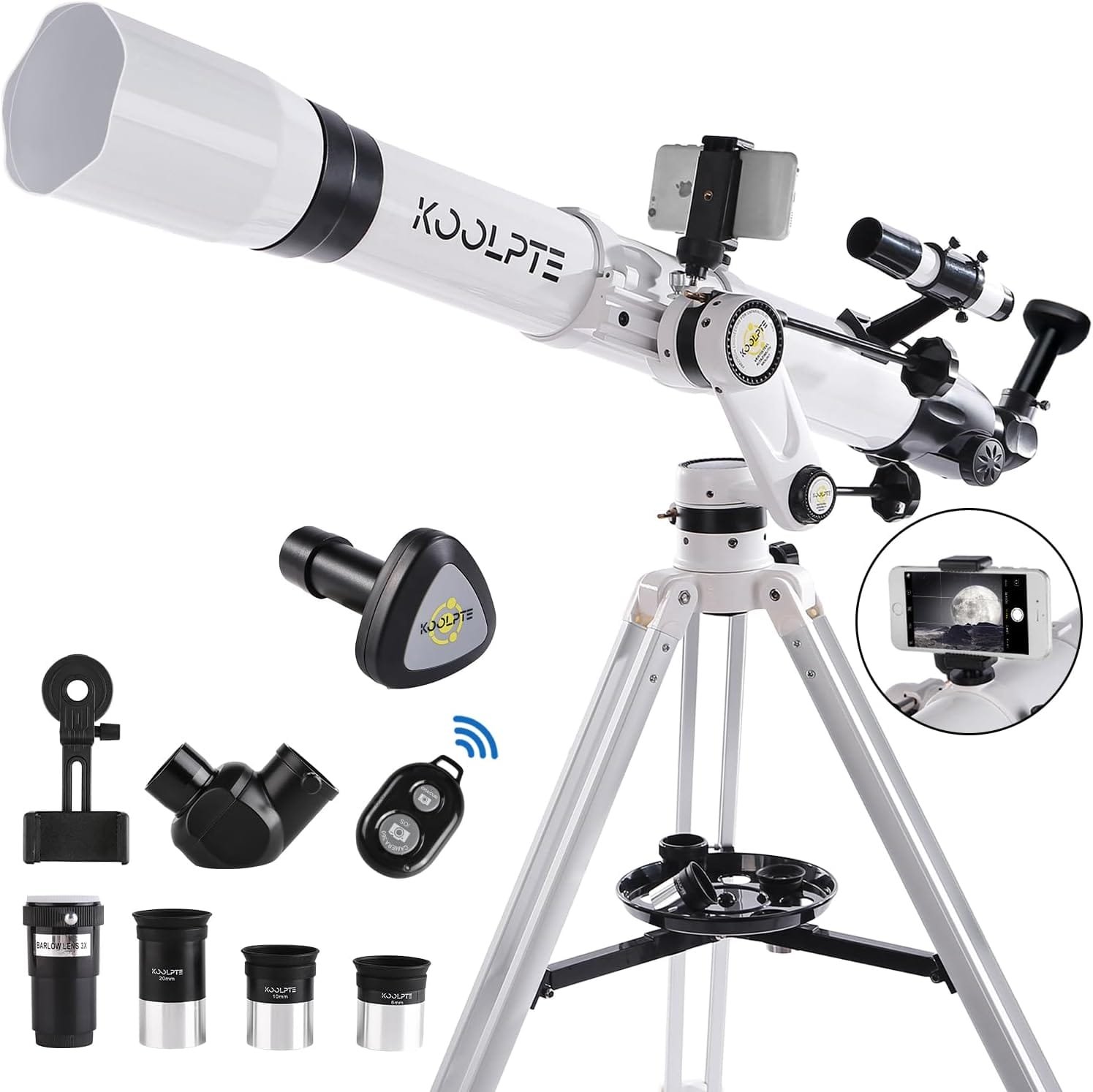
Koolpte 90mm Refractor with Digital Eyepiece
The Koolpte 90mm Refractor is a compact and lightweight telescope with a 90mm aperture, offering crisp views of the moon, planets, and more. It includes a digital eyepiece for easy observation and image capture.
A key feature is the digital eyepiece. It allows you to see and capture celestial objects on a screen. This makes it great for sharing your observations with friends and family. You can also take photos and videos of the night sky.
The Vertisteel Altazimuth mount provides smooth and stable movement, allowing you to track planets and stars easily. Its sturdy design gives you steady views at high magnification and ensures minimal vibrations.
This telescope is ideal for those who enjoy stargazing. It has advanced features for a great experience. The Koolpte 90mm refractor gives crisp, detailed images. It excels at observing Saturn’s rings, the Andromeda Galaxy, and distant star clusters.
Specs
| Specification | Details |
|---|---|
| Type | Refractor |
| Aperture | 90mm |
| Focal Length | 900mm |
| Mount Type | Vertisteel Altazimuth Mount |
| Weight | 9.37 kg (20.66 lbs) |
| Maximum Magnification | Not specified; however, theoretical maximum magnification is approximately 180x (calculated as 2 times the aperture in mm) |
| Finderscope | Red dot viewfinder |
| Tripod Material | Not specified; however, the Vertisteel Altazimuth Mount suggests a sturdy construction |
| Optical Coatings | Not specified; typically, refractor telescopes feature fully coated optics to enhance image clarity and brightness |
| Accessories Included | Digital eyepiece, 9mm and 20mm Kellner eyepieces, erect image diagonal, red dot viewfinder |
| Field of View | Not specified; depends on the eyepiece used |
| User Level | Suitable for beginners and professionals |
Pros
- Easy to use
- Good image quality
- Compact design
- Affordable price
- Suitable for beginners
- Versatile for all ages
Cons
- Heavy for portability
- Requires smartphone for full features
Best Features
- Digital Eyepiece
- 90mm Aperture
- Sturdy Mount
- Phone Adapter
- User-Friendly
Best Portable Telescope
Maksutov-Cassegrain 80 mm (850 mm focal length)
The Maksutov-Cassegrain 80mm is the perfect travel-friendly telescope for astronomy lovers. It has an 80mm aperture and an 850mm focal length. It provides clear views of planets, the Moon, and bright deep-sky objects.
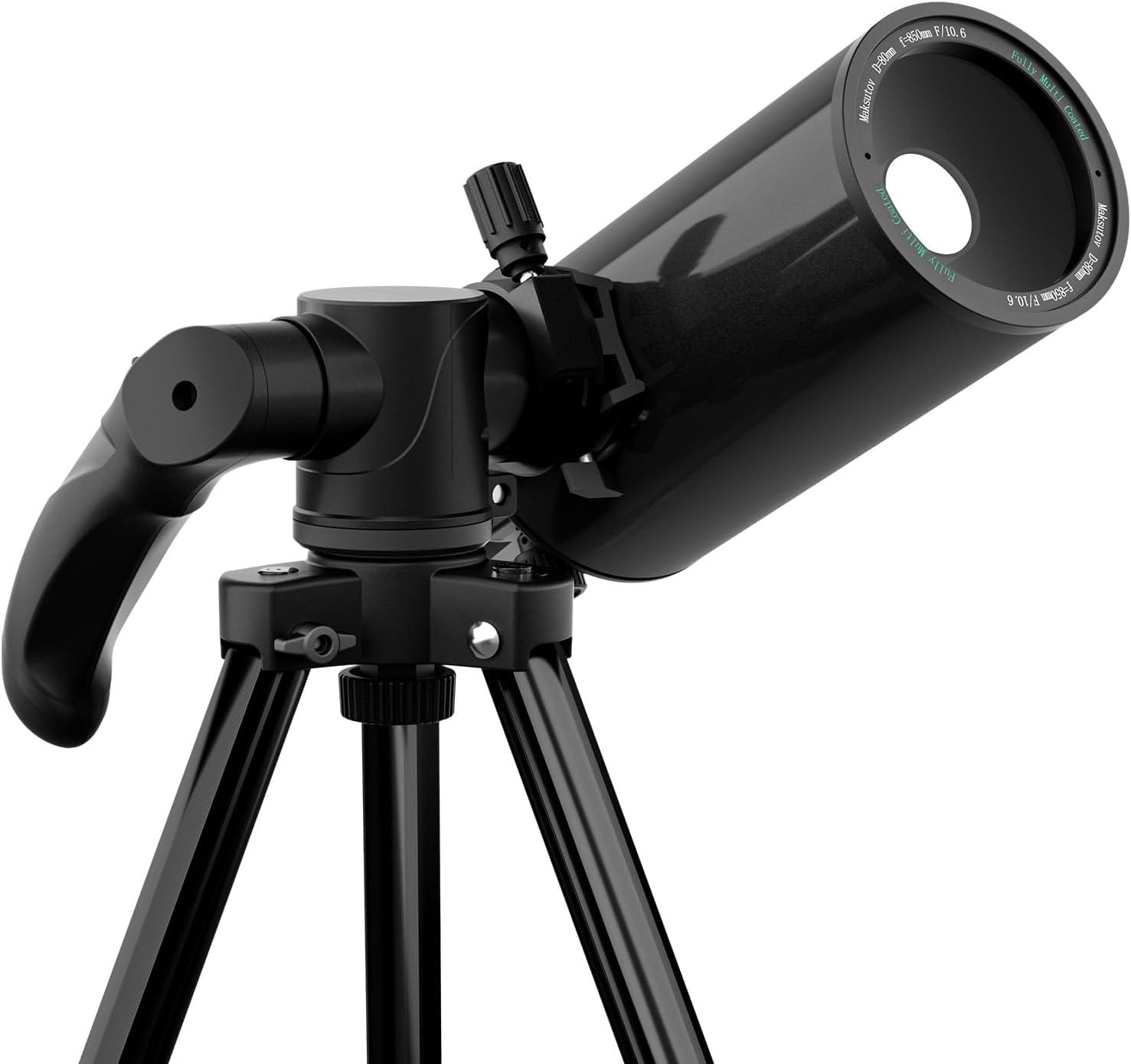
Maksutov-Cassegrain 80 mm (850 mm focal length)
The Maksutov-Cassegrain 80mm telescope features an 850mm focal length, delivering sharp, high-contrast views of the moon, planets, and deep-sky objects.
This telescope has a Maksutov-Cassegrain design. It’s compact and lightweight, yet it offers powerful magnification. The optical system reduces distortion and delivers sharp, high-contrast images.
Its compact design allows for easy portability on trips to dark-sky locations. You can set it up quickly and start observing in minutes. This telescope is made for easy transport and quick use in your backyard or on a mountain under a starry sky.
It offers high performance and is easy to use, making it great for beginners and experienced stargazers.
Specs
| Specification | Details |
|---|---|
| Type | Maksutov-Cassegrain |
| Aperture | 80 mm |
| Focal Length | 850 mm |
| Mount Type | Altazimuth |
| Weight | Approximately 4.21 kg (9.3 lbs) |
| Maximum Magnification | Up to 160x (theoretical), though practical magnification may vary based on observing conditions and eyepiece quality. |
| Finderscope | Reflex |
| Tripod Material | Typically, aluminum, offering a balance between stability and portability. |
| Optical Coatings | Fully multi-coated optics to enhance light transmission and reduce reflections, ensuring crisp and clear images. |
| Accessories Included | Commonly includes 10mm and 20mm eyepieces, a 90° diagonal for comfortable viewing, a smartphone adapter for astrophotography, and a carrying case for transport and storage. |
| Field of View | Approximately 1.25° with a 20mm eyepiece, providing a broad view of celestial objects. |
| User Level | Suitable for both beginners and intermediate users, offering a blend of user-friendly features and advanced capabilities. |
Pros
- Compact and portable
- Good image quality
- Easy to set up
- Includes phone adapter
Cons
- Limited magnification
- Limited Nighttime Use
- Requires Smartphone for Photos
Best Features
- Compact Design
- High Resolution
- Quick Focus
- Portable
- Sturdy Tripod
Best Complete Kit
Celestron StarSense Explorer 114mm Tabletop Dobsonian
The Celestron StarSense Explorer 114mm Tabletop Dobsonian is a great telescope. It’s perfect for beginners and seasoned stargazers. It comes with everything you need to start exploring the night sky immediately. The 114mm aperture collects a lot of light. It offers clear, vivid views of planets, the Moon, and deep-sky objects, including the Orion Nebula and the Andromeda Galaxy.
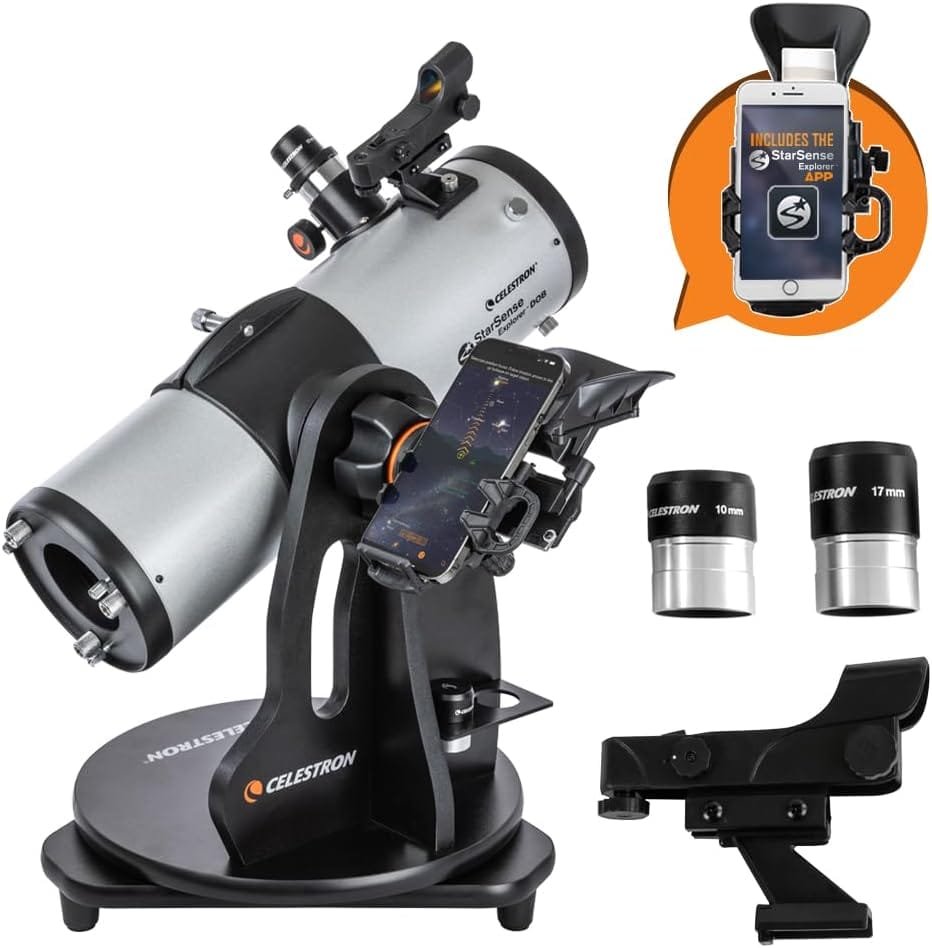
Celestron StarSense Explorer 114mm Tabletop Dobsonian
The Celestron StarSense Explorer 114mm Tabletop Dobsonian is a compact and beginner-friendly telescope featuring a 114mm aperture for bright, detailed views of the night sky.
What makes this telescope stand out is its StarSense technology. A smartphone app can help you find and track celestial objects. No prior experience is needed. Secure your phone, follow the on-screen arrows, and let the app guide you to your target. This feature enhances the stargazing experience, making it enjoyable and hassle-free for beginners.
The tabletop Dobsonian mount is user-friendly and delivers smooth motion. Compared to traditional tripods, it offers a stable foundation that minimizes vibrations for sharper views. Its lightweight, compact design makes it easy to transport and store, perfect for limited space.
Specs
| Specification | Details |
|---|---|
| Type | Newtonian Reflector |
| Aperture | 114mm (4.5 inches) |
| Focal Length | 450mm |
| Focal Ratio | f/4 |
| Mount Type | Altazimuth Tabletop Dobsonian base |
| Weight | 12.6 lbs (5.71 kg) |
| Highest Useful Magnification | 269x |
| Finderscope | StarPointer™ red-dot finderscope |
| Tripod Material | Not included; optional tripod available |
| Optical Coatings | Aluminum with SiO₂ overcoat |
| Accessories Included | 17mm (26x) and 10mm (45x) eyepieces, StarSense smartphone dock, StarPointer™ red-dot finderscope, eyepiece rack, collimation cap, Starry Night Basic Edition software, StarSense Explorer app with unlock code |
| Field of View | Dependent on eyepiece used; with included 17mm eyepiece, approximately 2 degrees |
| User Level | Beginner to Intermediate |
Pros
- Impressive views
- Stable mount
- Works well with app
Cons
- Base assembly required
- Not for astrophotography
Best Features
- Smartphone Integration
- Real-time Positioning
- Easy Setup
- High-Quality Optics
- Stable Base
Tips for Maximizing Your Planet Viewing Experience
Proper preparation is key to maximizing your observation sessions. These tips will help ensure a successful and enjoyable stargazing experience.
Plan the Perfect Viewing Time
The best times to observe planets are during “opposition” (when they’re closest to Earth) or dusk and dawn. Check celestial event calendars for key dates.
Optimize Your Setup
Place your telescope on a stable surface, away from light pollution. Let your telescope adjust to the outdoor temperature to avoid blurry images.
Use telescope filters.
Filters can enhance planetary views. For instance:
- Yellow filters improve contrast on Jupiter.
- Blue filters enhance Saturn’s ring details.
- Red filters help bring out Mars’ polar ice caps.
Check the weather.
Even the best telescope won’t deliver crisp views if the atmospheric conditions are poor. Use tools like Clear Sky Chart to find optimal viewing conditions.
Conclusion
Choosing the right telescope depends on your needs, experience level, and budget. A simple Dobsonian is best for easy viewing. For advanced tracking, choose a computerized telescope like the NexStar 6SE. There’s a perfect option for every stargazer.
The night sky is filled with wonders, and a good planetary telescope allows you to experience them up close. From Jupiter’s swirling clouds to Saturn’s icy rings, every planet has a story to tell. A quality telescope unlocks a lifetime of discovery and awe.


